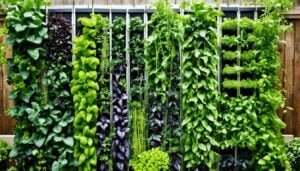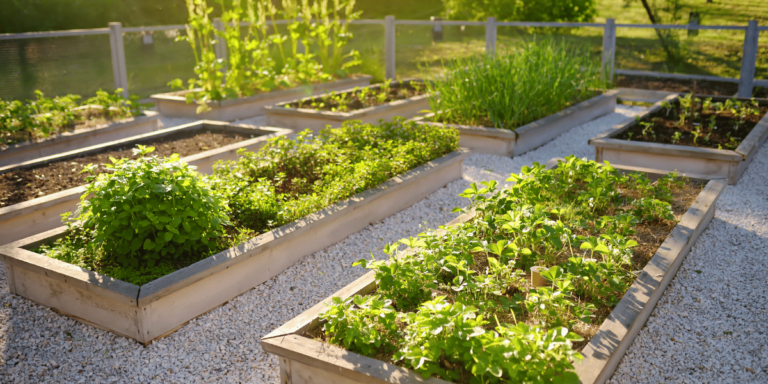Tips for Vertical vegetable gardening is a technique that allows gardeners to maximize their growing space by utilizing structures such as fences, trellises, and walls to grow vegetables vertically. This method offers several benefits, including increased yields, reduced plant problems, and easier maintenance. In addition, vertical gardens are a sustainable and eco-friendly way to create a beautiful landscape while conserving water and supporting wildlife habitats.
Key Takeaways:
- Tips for Vertical vegetable gardening is a technique that maximizes growing space by utilizing structures such as fences, trellises, and walls.
- Benefits of tips for vertical vegetable gardening include increased yields, reduced plant problems, and easier maintenance.
- tips for Vertical vegetable gardens are a sustainable and eco-friendly way to create a beautiful landscape.
- tips for Vertical vegetable gardens conserve water and support wildlife habitats.
- Vertical vegetable gardening can be adapted for indoor hydroponic systems and high-tech smart gardening techniques.
Benefits of Tips For Vertical Vegetable Gardens
Vertical gardening offers numerous benefits for gardeners. By utilizing vertical space, gardeners can increase their yields and make the most of limited urban areas. Vertical gardens also allow for the implementation of high-tech smart gardening techniques, such as automated watering systems and smart plant monitoring. Additionally, vertical gardening supports urban permaculture practices and can be adapted for indoor hydroponic systems.
Maximizing Yield in Limited Spaces
Vertical gardens are a space-efficient solution for urban areas where land is limited. By growing plants vertically, gardeners can maximize their growing area and achieve higher yields compared to traditional horizontal gardens. With proper planning and suitable plant selection, gardeners can enjoy a variety of vegetables, herbs, and flowers even in small spaces.
High-Tech Smart Gardening
Vertical gardening lends itself well to high-tech innovations, revolutionizing the way we cultivate plants. Gardeners can implement automated watering systems, using sensors and timers to provide plants with the right amount of water at the right time. Smart plant monitoring devices allow gardeners to track vital parameters such as humidity, temperature, and light levels, ensuring optimal growing conditions. These advancements in smart gardening technology make vertical gardening a truly cutting-edge and efficient practice.
Supporting Urban Permaculture Practices
Urban permaculture aims to create sustainable and self-sufficient systems in urban environments. Vertical gardening aligns perfectly with this philosophy by maximizing space efficiency and resource utilization. By incorporating permaculture principles such as companion planting, companion stacking, and nutrient cycling, gardeners can create thriving vertical gardens that contribute to a more sustainable urban ecosystem.
Adaptable for Indoor Hydroponic Systems
Indoor hydroponic systems, which allow plants to grow without soil and with minimal water usage, can be easily adapted for vertical gardening. By combining the benefits of hydroponics with vertical structures, gardeners can create flourishing indoor gardens that are not limited by space constraints. This opens up possibilities for year-round gardening, reducing dependence on external food sources and enabling sustainable lifestyles.
With its space-efficient design, adaptability to smart gardening technologies, support for urban permaculture practices, and compatibility with indoor hydroponic systems, vertical gardening is a versatile and sustainable solution for modern gardeners. Whether you have a small balcony, a rooftop, or a spacious backyard, vertical gardening empowers you to cultivate fresh produce and beautiful plants in any urban setting.
Choosing the Right Plants Tips for Vertical Gardens
When it comes to vertical gardening, selecting suitable plants that are well-suited for vertical growth is crucial. Vining and climbing plants are particularly ideal for vertical gardens, as they are adept at utilizing vertical space and can be trained to grow up trellises and other vertical structures. Some excellent choices for vertical gardening include:
- Pole beans
- Cucumbers
- Vining tomatoes
These plants not only take up minimal horizontal space, but they also thrive in upward growth patterns, making them a perfect fit for vertical gardens. By training them to climb, you can harness the benefits of vertical gardening and enjoy a bountiful harvest, even in limited spaces.
However, vertical gardens are not limited to just vining and climbing plants. You can also cultivate herbs and leafy greens vertically, using hanging baskets or wall-mounted pots. This allows you to utilize vertical space efficiently, especially in areas where horizontal space may be scarce.
Designing with Organic Composting Methods
In addition to choosing the right plants, incorporating organic composting methods into your vertical garden design can greatly enhance its sustainability and productivity. Organic composting involves recycling kitchen scraps, yard waste, and other organic materials to create nutrient-rich compost. By adding compost to your vertical garden, you can enrich the soil and provide essential nutrients to your plants, promoting healthy growth and increasing yields.
Embracing Green Roof Ecosystems
Another innovative approach to vertical gardening is the integration of green roof ecosystems. Green roofs are vegetated rooftop systems that provide an array of environmental benefits, including improved stormwater management, energy conservation, and the creation of wildlife habitats. By incorporating green roof ecosystems into vertical gardens, you can enhance biodiversity, conserve water, and contribute to a more sustainable urban environment.
Incorporating Contemporary Garden Artistry
Vertical gardens offer an opportunity to blend nature and art, creating visually stunning and contemporary garden spaces. By incorporating garden artistry, such as sculptures, wall murals, or unique plant arrangements, you can elevate the aesthetic appeal of your vertical garden. This fusion of nature and art not only enhances the overall visual experience but also adds a touch of creativity and personal expression to your garden design.
Applying Biophilic Design Principles
Biophilic design is an approach that seeks to connect people with nature through the integration of natural elements within built environments. When designing your vertical garden, you can embrace biophilic design principles by incorporating features such as flowing water, naturalistic plant arrangements, and ample greenery. This creates a harmonious and biophilic atmosphere that promotes wellbeing and evokes a sense of tranquility and connection to nature.
Creating Vertical Vegetable Garden Structures
When it comes to vertical gardening, there are numerous structures that can be used to create stunning and productive vertical gardens. These structures not only provide support for climbing vegetables but also maximize space, promote efficient gardening practices, and contribute to a greener environment. Whether you’re looking to incorporate smart garden automation, embark on an eco-friendly garden renovation project, or create space-efficient vertical gardens with green roof ecosystems, there are options to suit every gardener’s needs.
1. Trellises
Trellises are versatile structures that offer sturdy support for climbing plants, giving them the opportunity to grow upwards and expand their reach. Whether made of wood, metal, or even recycled materials, trellises can be designed in a range of styles and sizes to accommodate various plant types. They are particularly effective for growing vining vegetables such as beans, peas, and cucumbers.
2. Tripods
Tripods provide an artistic and space-saving solution for vertical gardening. Made from sturdy materials like bamboo or metal, these three-legged structures offer stability and visual interest to your garden. Tripods can be used to support climbing plants or even create a focal point with hanging baskets or cascading flowers.
3. Arches and Pergolas
Arches and pergolas are not only aesthetically pleasing but also provide a vertical growing space for climbing plants. These structures add a touch of elegance to any garden while creating a natural canopy for shade-loving plants. With a little creativity, arches and pergolas can be customized to suit your garden’s style and space.
4. Wall Training and Wire Supports
For sturdier plants like fruit trees or espalier techniques, wall training and wire supports are essential. By securely attaching branches to a wall or fence and using wires or mesh for additional support, you can guide the growth of these plants vertically, saving space and creating a unique garden feature.
5. Smart Garden Automation
Take your vertical garden to the next level by incorporating smart garden automation. Automated watering systems, sensor-based monitoring, and advanced lighting solutions can streamline your gardening process and help you achieve optimal plant growth. With smart technology, you can ensure your vertical garden thrives while conserving water and minimizing maintenance efforts.
6. Eco-Friendly Garden Renovation
Vertical gardening can be a perfect addition to an eco-friendly garden renovation project. By incorporating principles of sustainability, such as using recycled materials for structures and employing organic gardening practices, you can create a harmonious and environmentally conscious outdoor space that supports plant growth, conserves resources, and encourages biodiversity.
7. Green Roof Ecosystems
Green roofs are becoming increasingly popular as a means of utilizing vertical space and creating thriving ecosystems. These rooftops adorned with vegetation enhance energy efficiency, improve air quality, reduce stormwater runoff, and provide habitat for birds, insects, and other wildlife. Incorporating green roof ecosystems into your vertical garden design not only maximizes your gardening space but also contributes to a healthier urban environment.
No matter the structure you choose for your vertical garden, the key is to create an environment that promotes plant growth, maximizes space, and aligns with your sustainability goals. Consider combining different structures for a visually appealing and functional garden that reflects your unique style and values.
| Structure | Benefits |
|---|---|
| Trellises | Provides support for climbing plants Maximizes vertical space Enables easier harvesting and maintenance |
| Tripods | Offers space-saving solution Adds visual interest and artistic flair Allows for versatile plant placements |
| Arches and Pergolas | Creates an elegant vertical growing space Provides shade for shade-loving plants Enhances the aesthetic appeal of the garden |
| Wall Training & Wire Supports | Guides the growth of sturdier plants Maximizes wall or fence space Creates unique garden features |
| Smart Garden Automation | Automates watering and monitoring Saves water and minimizes maintenance Enhances plant growth prospects |
| Eco-Friendly Garden Renovation | Utilizes recycled materials Promotes organic gardening practices Supports biodiversity and conserves resources |
| Green Roof Ecosystems | Utilizes roof space for vertical gardening Enhances energy efficiency Contributes to a healthier urban environment |
DIY Tips For Vertical Vegetable Gardens Ideas

Are you looking for creative ways to incorporate sustainable urban gardening practices into your own urban space? Look no further! We’ve compiled a list of DIY vertical gardening ideas that will not only help you make the most of your limited space but also promote innovative water conservation techniques, renewable energy use in eco-gardens, and the creation of wildlife habitat gardens.
Create a Living Wall
- Use a trellis panel and a range of pots to create a living wall
- Plant herbs, vegetables, and flowers in the pots
- Hang the pots on the trellis panel
- This not only adds greenery to your space but also maximizes vertical growing potential
Build a Vegetable Arch
- Construct a vegetable arch using galvanized metal uprights and cattle panels
- This sturdy structure creates a vertical space for climbing vegetables
- Train the plants to grow up the arch, saving valuable ground space
- Enjoy a beautiful and productive garden feature
Construct a Bean Teepee
- Use bamboo canes or other long, straight prunings to construct a bean teepee
- Plant climbing beans around the teepee
- As the beans grow, they will create a natural and attractive structure
- Harvest fresh beans while creating a unique focal point in your garden
Make a Pallet Planter
- Recycle wooden pallets to make a vertical pallet planter
- Arrange the pallets vertically and secure them together
- Fill the spaces between the slats with soil and plant your favorite herbs and vegetables
- This DIY project is not only economical but also eco-friendly
By implementing these DIY vertical gardening ideas, you’ll not only create a green oasis in your urban space but also contribute to sustainable urban gardening practices, innovative water conservation techniques, renewable energy use in eco-gardens, and the creation of wildlife habitat gardens. So roll up your sleeves and start enjoying the benefits of vertical gardening today!
Conclusion
Tips for Vertical vegetable gardens offer a practical and eco-friendly solution for maximizing urban gardening space. By utilizing vertical structures and selecting suitable plants, gardeners can increase their yields, reduce plant problems, and create a sustainable and beautiful landscape.
With eco-friendly landscape design at the forefront, vertical gardens not only provide food but also contribute to the conservation of resources and the creation of wildlife habitats. By incorporating renewable energy in eco-gardens, such as solar-powered watering systems, gardeners can further reduce their ecological footprint and promote sustainability.
So whether you’re a beginner looking to start a small DIY project or an experienced gardener interested in creating a more complex vertical garden design, vertical vegetable gardens offer a range of benefits. From compact urban spaces to expansive landscapes, these versatile gardens can be customized to fit any area and elevate your eco-friendly gardening game. Start growing up with vertical vegetable gardens and enjoy the rewards of a greener, more sustainable garden.
FAQ
What is tips for vertical vegetable gardens?
Tips for Vertical vegetable gardens is a technique that allows gardeners to maximize their growing space by utilizing structures such as fences, trellises, and walls to grow vegetables vertically.
What are the benefits of vertical gardening?
Vertical gardening offers increased yields, reduced plant problems, and easier maintenance. It also supports sustainable and eco-friendly practices, conserves water, and creates wildlife habitats.
What plants are suitable for vertical gardening?
Vining and climbing plants such as pole beans, cucumbers, and vining tomatoes are ideal for vertical gardens. Herbs and leafy greens can also be grown vertically using hanging baskets or wall-mounted pots.
What structures can be used to create vertical gardens?
Trellises, tripods, arches, and pergolas are popular options for supporting climbing vegetables. Wall training and wire supports can be used for sturdier plants like fruit trees. Smart garden automation can also be incorporated into vertical gardens.
What are some DIY vertical gardening ideas?
DIY ideas include creating a living wall using a trellis panel and pots, building a vegetable arch using metal uprights and cattle panels, constructing a bean teepee using bamboo canes, and making a pallet planter using recycled wooden pallets.










